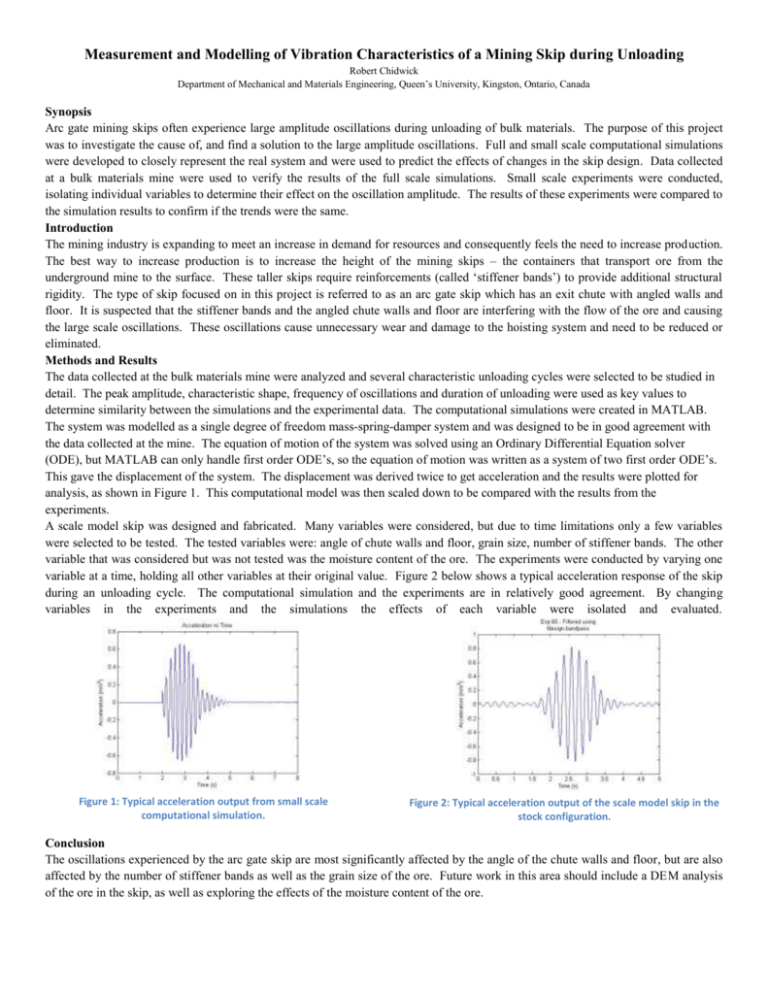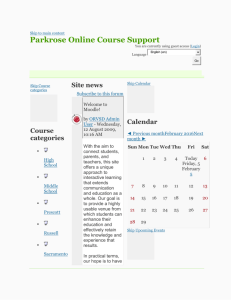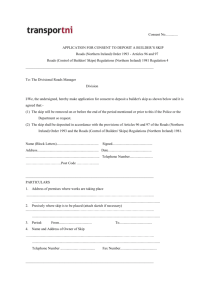Arc gate mining skips often experience large amplitude oscillations
advertisement

Measurement and Modelling of Vibration Characteristics of a Mining Skip during Unloading Robert Chidwick Department of Mechanical and Materials Engineering, Queen’s University, Kingston, Ontario, Canada Synopsis Arc gate mining skips often experience large amplitude oscillations during unloading of bulk materials. The purpose of this project was to investigate the cause of, and find a solution to the large amplitude oscillations. Full and small scale computational simulations were developed to closely represent the real system and were used to predict the effects of changes in the skip design. Data collected at a bulk materials mine were used to verify the results of the full scale simulations. Small scale experiments were conducted, isolating individual variables to determine their effect on the oscillation amplitude. The results of these experiments were compared to the simulation results to confirm if the trends were the same. Introduction The mining industry is expanding to meet an increase in demand for resources and consequently feels the need to increase production. The best way to increase production is to increase the height of the mining skips – the containers that transport ore from the underground mine to the surface. These taller skips require reinforcements (called ‘stiffener bands’) to provide additional structural rigidity. The type of skip focused on in this project is referred to as an arc gate skip which has an exit chute with angled walls and floor. It is suspected that the stiffener bands and the angled chute walls and floor are interfering with the flow of the ore and causing the large scale oscillations. These oscillations cause unnecessary wear and damage to the hoisting system and need to be reduced or eliminated. Methods and Results The data collected at the bulk materials mine were analyzed and several characteristic unloading cycles were selected to be studied in detail. The peak amplitude, characteristic shape, frequency of oscillations and duration of unloading were used as key values to determine similarity between the simulations and the experimental data. The computational simulations were created in MATLAB. The system was modelled as a single degree of freedom mass-spring-damper system and was designed to be in good agreement with the data collected at the mine. The equation of motion of the system was solved using an Ordinary Differential Equation solver (ODE), but MATLAB can only handle first order ODE’s, so the equation of motion was written as a system of two first order ODE’s. This gave the displacement of the system. The displacement was derived twice to get acceleration and the results were plotted for analysis, as shown in Figure 1. This computational model was then scaled down to be compared with the results from the experiments. A scale model skip was designed and fabricated. Many variables were considered, but due to time limitations only a few variables were selected to be tested. The tested variables were: angle of chute walls and floor, grain size, number of stiffener bands. The other variable that was considered but was not tested was the moisture content of the ore. The experiments were conducted by varying one variable at a time, holding all other variables at their original value. Figure 2 below shows a typical acceleration response of the skip during an unloading cycle. The computational simulation and the experiments are in relatively good agreement. By changing variables in the experiments and the simulations the effects of each variable were isolated and evaluated. Figure 1: Typical acceleration output from small scale computational simulation. Figure 2: Typical acceleration output of the scale model skip in the stock configuration. Conclusion The oscillations experienced by the arc gate skip are most significantly affected by the angle of the chute walls and floor, but are also affected by the number of stiffener bands as well as the grain size of the ore. Future work in this area should include a DEM analysis of the ore in the skip, as well as exploring the effects of the moisture content of the ore.



